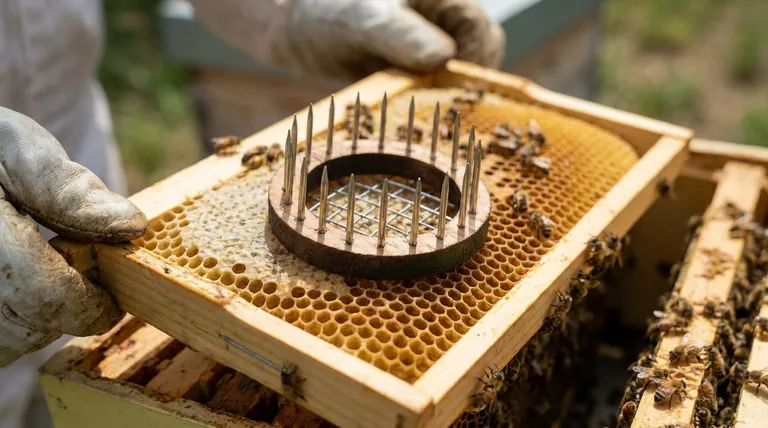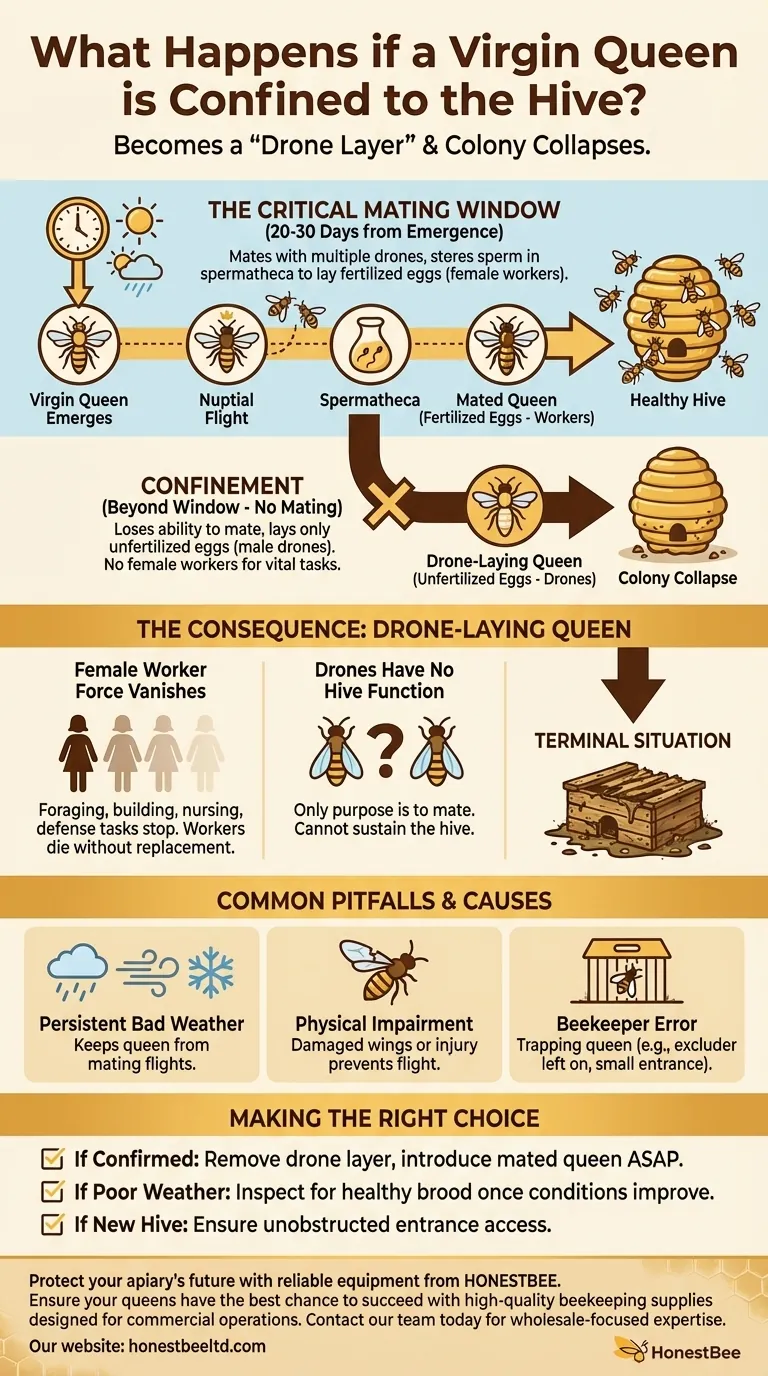In short, a virgin queen confined to the hive for too long becomes a "drone layer." If she is unable to take her mating flights within approximately three weeks of emerging, she loses the ability to mate successfully. She will then begin to lay only unfertilized eggs, which develop into male bees (drones), a path that will ultimately lead to the colony's collapse if left uncorrected.
A honey bee queen operates on a strict biological clock. Missing the critical window for mating permanently renders her unable to lay the fertilized eggs required to produce female workers, dooming the colony she was meant to lead.

The Queen's Critical Mating Window
A new queen's primary biological purpose is to mate and secure the genetic material needed to populate a hive for years to come. This process is time-sensitive and happens outside the hive.
The Nuptial Flight
Shortly after emerging, a virgin queen embarks on one or more "nuptial flights." She flies to a specific location known as a Drone Congregation Area (DCA), where thousands of drones from various colonies have gathered.
She mates with multiple drones in mid-air to collect a diverse and sufficient supply of sperm.
The Role of the Spermatheca
The queen stores all the sperm she will ever collect in a specialized organ called the spermatheca. For the rest of her life, she will use this stored sperm to fertilize eggs as she lays them.
A fertilized egg develops into a female bee (either a worker or a new queen), while an unfertilized egg develops into a male bee (a drone).
The Biological Clock Ticks Down
A queen has a limited window of roughly 20-30 days from when she emerges to successfully mate. If she is prevented from flying during this period, her reproductive physiology changes, and she loses the ability or instinct to mate.
The Consequence: A Drone-Laying Queen
When an unmated queen begins to lay eggs, she can only produce drones. This creates a terminal situation for the colony.
The Colony's Workforce Vanishes
A honey bee colony is overwhelmingly female. The female worker bees are responsible for every critical task: foraging for food, building wax comb, nursing the young, and defending the hive.
Drones have only one purpose: to mate with a queen. They do not contribute to the daily work of the hive and cannot sustain it.
The End of the Colony
As the existing worker bees die of old age, there are no new female workers to replace them. The hive's population dwindles, its resources are consumed, and it eventually collapses from a lack of a functional workforce.
Common Pitfalls and Causes
A queen's confinement is rarely intentional and is usually the result of factors outside the beekeeper's immediate control.
Persistent Bad Weather
This is the most common cause. Long stretches of rain, high winds, or cold temperatures can keep a virgin queen from taking her essential mating flights until it is too late.
Physical Impairment
A queen born with damaged wings or who suffers an injury that prevents flight cannot leave the hive to mate.
Beekeeper Error
Accidentally trapping a queen can also occur. This might happen if a queen excluder is left over the main entrance or if an entrance reducer is too small, effectively imprisoning her within the hive.
Making the Right Choice for Your Hive
Once a queen is confirmed to be a drone layer, decisive action is the only way to save the colony.
- If you have confirmed a drone-laying queen: You must find and remove her, then introduce a new, mated queen as soon as possible.
- If you are tracking a new virgin queen during poor weather: Be prepared to inspect the hive as soon as conditions improve to check for a healthy brood pattern, which is the sign of a successful mating.
- If you are managing a new hive split or swarm: Ensure the virgin queen has unobstructed access to the hive entrance and monitor her progress.
Understanding the queen's vital and time-sensitive role is fundamental to successful beekeeping.
Summary Table:
| Consequence of Confinement | Outcome for the Colony |
|---|---|
| Queen becomes a "drone layer" | Lays only unfertilized eggs, producing male drones |
| Loss of female worker population | No new bees to forage, nurse young, or defend the hive |
| Colony population dwindles | Hive resources are consumed without being replenished |
| Eventual colony collapse | The hive fails due to a lack of a functional workforce |
Protect your apiary's future with reliable equipment from HONESTBEE. A drone-laying queen can devastate a colony's productivity. Ensure your queens have the best chance to succeed with high-quality beekeeping supplies designed for commercial operations and distributors. Let our wholesale-focused expertise help you maintain strong, productive hives. Contact our team today to discuss your equipment needs and secure your colony's health.
Visual Guide

Related Products
- Wood and Mesh Push-In Queen Cage
- Multi-Function Queen Roller Cage and Catcher
- Professional Multi-Functional Queen Bee Cage
- Professional Round Push-In Queen Cage with Metal Tines
- Classic Wooden and Mesh California Queen Cage
People Also Ask
- What are key factors for successful beekeeping with a new queen? A Guide to Flawless Queen Introduction
- What is a push-in queen cage and how does it differ from standard cages? Achieve Higher Queen Acceptance Rates
- What happens when bees do not recognize a queen as part of their hive? The Deadly Process of Queen Rejection
- What should be done before removing the queen cage from the hive? Ensure Your New Queen is Accepted & Laying
- Are queen cages reusable? Yes, with proper cleaning for sustainable beekeeping.


















